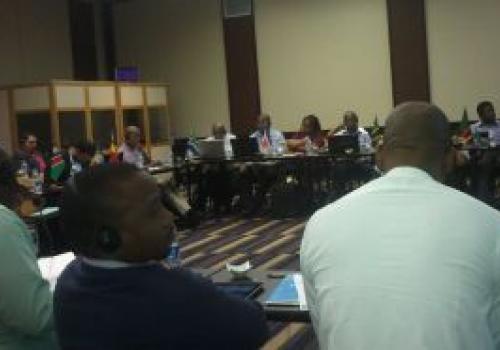The SADC Investment Policy Framework (IPF) held its fourth Investment Focus Group meeting on October 20-22, 2014 in Pretoria, South Africa.The objective of the meeting was for member States to discuss the draft analytical reports for the second set of two policy pillars ...
These reports were based on responses to questionnaires on foreign direct investment (FDI) restrictions and investor protection. The tax incentives for investment and infrastructure investment having been reviewed at the last meeting held on July 3 – 4 ,2014 in Pretoria, South Africa as well.
Application of the Paperless communication
The highly consultative approach used in the development of the IPF requires significant exchange of information among stakeholders; some of the materials are bulky and often cannot be relayed via email. The preparatory material generated before an event or a workshop and the reports produced after have also to be easily accessible to both internal and external stakeholders for further consultations.
The Investment Unit of Trade, Industry, Finance an Investment (TIFI) Directorate has therefore worked very closely with the ICT Unit to optimally use ICT facilities available at the Secretariat; the Extranet and the internal TIFI shared drive. These have improved the efficiency in the development of the SADC-IPF by enhancing the preparedness of participants to meetings, and avoiding carrying heavy and costly documents as well as correct scheduling of meetings.
The programme has set up dedicated web pages on the SADC Extranet (https://extranet.sadc.int). These pages are used to organise and share calendars, documents, contact details and data. Discussions are facilitated using discussion forums. Stakeholders from Member States and ICPs were registered on the Extranet to allow them to login using their email addresses and passwords. This facility has been successfully used to share documents with Member States and ICPs in the last three investment meetings especially during the course of developing the SADC IPF. The process has also proved to be a useful platform for peer learning and knowledge-sharing among Member States and Investment Promotion Agencies.
A uniform structure has been used to organise information for meetings and each event has a web page with the following headings:
- Agenda for the meeting
- Discussion materials
- Presentations
- Meeting reports
Using this approach, stakeholders get accustomed to where information is located and how it is organised. Since the extranet is a web-based system, the information can be accessed from anywhere at any time. This eliminates the need to send emails with massive megabyte attachments. Such emails often fail to be delivered when a recipient’s mailbox is full or when there are challenges with internet capacity or connectivity.
For purposes of sharing information internally, a similar structure of information was put in place on the TIFI shared Drive; a file system that was established with technical assistance from GIZ in support of the Secretariat’s knowledge management programme. The hierarchy of folders on the drive is structured in compliance with the file classification scheme that was designed under the Secretariat’s records management programme.
The SADC Investment Policy Framework being developed under the Regional Economic Integration Support (REIS) programme, which is funded by the EU, aims to facilitate a co-ordinated improvement of the investment climate and the ease of doing business across SADC Member States.By 2015 the project will have defined common guidelines on four topics which are: tax incentives for investment; infrastructure investment; restrictions on Foreign Direct Investment (FDI); and investor protection. An essential dimension of the project includes peer-learning and experience sharing among Member States.
SADC Secretariat and Member States facilitated the development process of the SADC IPF which has included the following activities:
- Stock-taking of member states’ investment policy programmes using diagnostic questionnaires;
- SADC Member States inputs through questionnaire responses and the drafting of analytical reports that proffer practical recommendations for implementation; and
- The common guidelines developed together with analytical reports on the four topics mentioned above will be formalized and endorsed by SADC Ministers in 2015.

